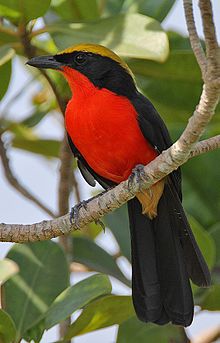Yellow-crowned gonolek
| Yellow-crowned gonolek | |
|---|---|

| |
| Scientific classification | |
| Domain: | Eukaryota |
| Kingdom: | Animalia |
| Phylum: | Chordata |
| Class: | Aves |
| Order: | Passeriformes |
| Family: | Malaconotidae |
| Genus: | Laniarius |
| Species: | L. barbarus
|
| Binomial name | |
| Laniarius barbarus (Linnaeus, 1766)
| |
| Synonyms | |
|
Lanius barbarus Linnaeus, 1766 | |
The yellow-crowned gonolek (Laniarius barbarus), also known as the common gonolek, is a medium-sized passerine bird in the bushshrike family. It is a common resident breeding bird in equatorial Africa from Senegal and Democratic Republic of Congo east to Ethiopia. It is a skulking bird and frequents dense undergrowth in forests and other wooded habitats. The nest is a cup structure in a bush or tree in which two eggs are laid.
Taxonomy
[edit]In 1760 the French zoologist Mathurin Jacques Brisson included a description of the yellow-crowned gonolek in his Ornithologie based on a specimen collected in Senegal. He used the French name La pie-griesche rouge du Sénégal and the Latin Lanius Senegalensis ruber.[2] Although Brisson coined Latin names, these do not conform to the binomial system and are not recognised by the International Commission on Zoological Nomenclature.[3] When in 1766 the Swedish naturalist Carl Linnaeus updated his Systema Naturae for the twelfth edition, he added 240 species that had been previously described by Brisson.[3] One of these was the yellow-crowned gonolek. Linnaeus included a brief description, coined the binomial name Lanius barbarus and cited Brisson's work.[4] The species is now placed in the genus Laniarius that was introduced by the French ornithologist Louis Pierre Vieillot in 1816.[5] Two subspecies are recognised.[6]
Description
[edit]The yellow-crowned gonolek is 22 cm (8.7 in) long with a long tail and short wings. The adult is a vividly-coloured bird, although easily overlooked as it lurks in undergrowth. It has solidly black upper parts apart from its golden crown, and scarlet underparts other than a buff-yellow undertail. The legs are dark. Sexes are similar, but juveniles are paler and duller.[7]
Ecology
[edit]This species is seldom seen because it inhabits thick undergrowth from which its calls can be heard. These include whistles and rattles, often sung in duet, with a fluted too-lioo overlapped by a rattling ch-chacha. The yellow-crowned gonolek feeds mainly on insects located in bushes or on the ground. The diet consists mostly of beetles and caterpillars, but birds eggs and nestlings are sometimes taken.[7]
It is monogamous and territorial. Some courtship behaviours have been observed with a pair chasing each other through a bush, leaping from branch to branch and emitting metallic twanging sounds. The deep cup-shaped nest is often flimsy and is built in a bush, from rootlets and tendrils. Two, or occasionally three, greyish-green or bluish-green eggs with dark spots are laid.[7]
References
[edit]- ^ BirdLife International (2016). "Laniarius barbarus". IUCN Red List of Threatened Species. 2016: e.T22707575A94130248. doi:10.2305/IUCN.UK.2016-3.RLTS.T22707575A94130248.en. Retrieved 12 November 2021.
- ^ Brisson, Mathurin Jacques (1760). Ornithologie, ou, Méthode contenant la division des oiseaux en ordres, sections, genres, especes & leurs variétés (in French and Latin). Vol. 2. Paris: Jean-Baptiste Bauche. pp. 185–187, Plate 17 fig 2. The two stars (**) at the start of the section indicates that Brisson based his description on the examination of a specimen.
- ^ a b Allen, J.A. (1910). "Collation of Brisson's genera of birds with those of Linnaeus". Bulletin of the American Museum of Natural History. 28: 317–335. hdl:2246/678.
- ^ Linnaeus, Carl (1766). Systema naturae : per regna tria natura, secundum classes, ordines, genera, species, cum characteribus, differentiis, synonymis, locis (in Latin). Vol. 1, Part 1 (12th ed.). Holmiae (Stockholm): Laurentii Salvii. p. 137.
- ^ Vieillot, Louis Pierre (1816). Analyse d'une Nouvelle Ornithologie Élémentaire (in French). Paris: Deterville/self. p. 41.
- ^ Gill, Frank; Donsker, David, eds. (2018). "Batises, woodshrikes, bushshrikes, vangas". World Bird List Version 8.1. International Ornithologists' Union. Retrieved 21 June 2018.
- ^ a b c Harris, Tony (2010). Shrikes and Bush-shrikes: Including Wood-shrikes, Helmet-shrikes, Shrike Flycatchers, Philentomas, Batises and Wattle-eyes. Bloomsbury Publishing. pp. 248–249. ISBN 978-1-4081-3459-7.
- Birds of The Gambia by Barlow, Wacher and Disley, ISBN 1-873403-32-1
Lua error in Module:Navbox at line 192: attempt to concatenate field 'argHash' (a nil value).

